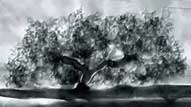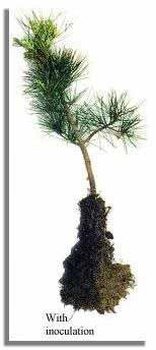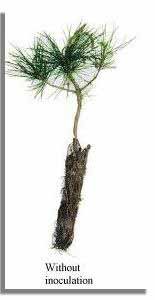Do I Need Mycorrhizae?

Do I Need Mycorrhizae? In today’s man-made environments plants can be greatly stressed and the relationship between fungus and root is critical. Unnatural conditions such as concrete, asphalt, roadsides, sidewalk cut outs, trenching, drain fields, air pollution, shopping malls, business districts, and suburban developments adversely effect the presence and abundance of mycorrhizal fungi.
Man-made environments often suffer from disturbance, compaction, top soil loss, and the absence of quality organic matter, conditions which reduce the habitat necessary for the mycorrhizal fungus to survive and thrive. Artificial landscapes effect the mycorrhizal relationship in two fundamental ways. First, they isolate the plant from beneficial mycorrhizal fungi available in natural settings and, secondly, they increase plant stress and the need for water, nutrients, and soil structure mediated by their below-ground “partners”. Many nursery and agricultural soils lack mycorrhizae due to excessive and long-term uses of chemical fertilizers and pesticides.
Determining the Need for Mycorrhizal Inoculation
When water and soluble nutrients are amply provided, non-mycorrhizal seedlings can grow well in artificial growing media. However, until they form mycorrhizae, they do not adequately take up water and nutrients upon outplanting. Routine nursery practices such as fumigation, and high levels of water and nutrients produce non-mycorrhizal seedlings or seedlings with “nursery fungi” poorly adapted to individual species or field conditions. Mycorrhizal Application, Inc. supplies MycoApply® spores of native mycorrhizal fungi that are specific to particular plants and function effectively in both the nursery and field environment.
Numerous scientific tests demonstrate that inoculating can: reduce culls; protect against pathogens; promote crop uniformity; reduce fertilizer use; reduce stunting; decrease shock; increase field survival; and increase field growth.
Man-made environments often suffer from disturbance, compaction, top soil loss, and the absence of quality organic matter, conditions which reduce the habitat necessary for the mycorrhizal fungus to survive and thrive. Artificial landscapes effect the mycorrhizal relationship in two fundamental ways. First, they isolate the plant from beneficial mycorrhizal fungi available in natural settings and, secondly, they increase plant stress and the need for water, nutrients, and soil structure mediated by their below-ground “partners”. Many nursery and agricultural soils lack mycorrhizae due to excessive and long-term uses of chemical fertilizers and pesticides.
Determining the Need for Mycorrhizal Inoculation
When water and soluble nutrients are amply provided, non-mycorrhizal seedlings can grow well in artificial growing media. However, until they form mycorrhizae, they do not adequately take up water and nutrients upon outplanting. Routine nursery practices such as fumigation, and high levels of water and nutrients produce non-mycorrhizal seedlings or seedlings with “nursery fungi” poorly adapted to individual species or field conditions. Mycorrhizal Application, Inc. supplies MycoApply® spores of native mycorrhizal fungi that are specific to particular plants and function effectively in both the nursery and field environment.
Numerous scientific tests demonstrate that inoculating can: reduce culls; protect against pathogens; promote crop uniformity; reduce fertilizer use; reduce stunting; decrease shock; increase field survival; and increase field growth.

